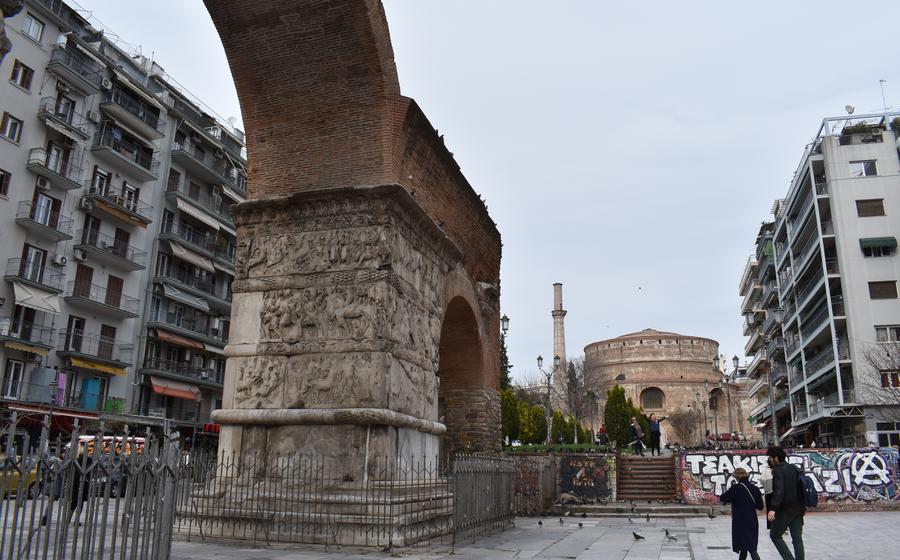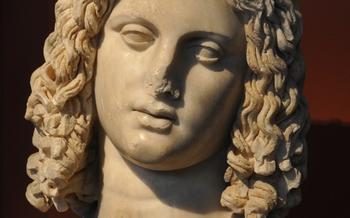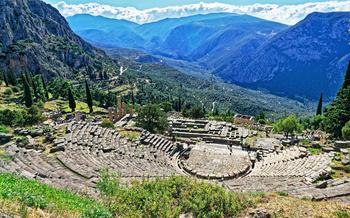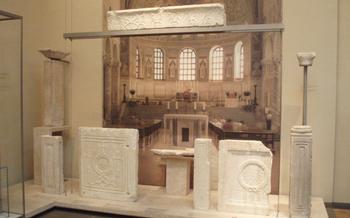
Rotunda of Galerius
- Historical Significance
- Architectural Marvel
- UNESCO World Heritage Site
- Rotunda's Transformation: Embrace of Christianity
- Unique Acoustics
- Religious Significance
- Changing Roles
- Surrounding Area
- Exhibitions and Events
- Visiting Information
- Photography Tips
- Nearby Restaurants:
- Transportation
- A Hidden Gem: The Rotunda's Secret Passage
Historical Significance
In the heart of Thessaloniki, Greece, stands the Rotunda of Galerius, an iconic monument that has witnessed the passage of time and played a pivotal role in the city's rich history. Built in the early 4th century AD by the Roman emperor Galerius, this imposing edifice was initially conceived as a temple dedicated to the Roman gods. However, its fate took an unexpected turn when the Roman Empire embraced Christianity, and the Rotunda underwent a remarkable transformation, becoming a Christian church. This transition marked a significant chapter in the Rotunda's history, as it became a symbol of the city's religious and cultural evolution.
Architectural Marvel
The Rotunda of Galerius stands as an architectural masterpiece, showcasing a unique blend of Roman and Byzantine influences. Its imposing cylindrical structure rises to a height of 30 meters, topped by an impressive dome that dominates the skyline of Thessaloniki. The exterior of the building is adorned with intricate carvings and sculptures, depicting mythological scenes and motifs. The circular shape of the Rotunda sets it apart from traditional Roman temples, which typically featured rectangular floor plans. This unique design choice enhances the building's acoustics, creating a resonant chamber that amplifies sound and contributes to its exceptional musical qualities.
UNESCO World Heritage Site
The Rotunda of Galerius holds a prestigious position as a UNESCO World Heritage Site, recognized for its exceptional cultural and historical significance. This designation highlights the Rotunda's status as a well-preserved example of Roman architecture, demonstrating the enduring legacy of the Roman Empire. Its inclusion on the UNESCO World Heritage List underscores its universal value and the need for its protection and preservation for future generations. As a testament to its cultural heritage, the Rotunda stands as a symbol of Thessaloniki's rich past and its enduring contribution to global history.
Rotunda's Transformation: Embrace of Christianity
During the Byzantine era, the Rotunda underwent a significant transformation, transitioning from a Roman temple dedicated to Galerius to a Christian church. This metamorphosis reflected the changing religious landscape of the empire as Christianity gained prominence. The interior of the Rotunda was adorned with stunning Byzantine mosaics depicting scenes from the life of Constantine the Great, the first Christian emperor of Rome. These intricate mosaics showcased the artistic prowess of the Byzantine era and served as a testament to the growing influence of Christianity.
The transition to a Christian church necessitated architectural changes to accommodate Christian worship. An apse, a semicircular recess, was added to the eastern end of the building, serving as the focal point for religious ceremonies. The apse was decorated with intricate mosaics depicting biblical scenes, further emphasizing the building's new religious function. The Rotunda's transformation into a Christian church stands as a testament to the adaptability and resilience of this ancient structure, embodying the changing religious and cultural landscape of the Byzantine Empire.
Unique Acoustics
The Rotunda of Galerius boasts exceptional acoustics, making it a sought-after venue for concerts and musical performances. The circular shape and domed ceiling create a reverberant environment, allowing sound to resonate and envelop the entire space. This acoustic phenomenon was not merely a coincidence but a deliberate design feature, as the Romans were skilled in constructing buildings with optimal acoustics.
One of the most remarkable anecdotes about the Rotunda's acoustics is the story of a famous opera singer who performed inside the building. As she sang, her voice reverberated throughout the Rotunda, creating a mesmerizing effect that captivated the audience. The singer was so moved by the experience that she declared it to be the most magical performance of her career.
To this day, the Rotunda continues to host concerts and musical events, allowing visitors to experience its unique acoustics firsthand. Whether it's a symphony orchestra, a choir, or a solo performer, the Rotunda provides an immersive and unforgettable auditory experience.
Religious Significance
The Rotunda of Galerius holds immense religious significance as a Christian church dedicated to Saint George, a revered figure in both Eastern Orthodox and Catholic traditions. Following its transformation into a Christian church during the Byzantine era, the Rotunda underwent symbolic changes to reflect its new purpose. The interior murals, depicting scenes from the life of Constantine the Great, serve as a testament to the building's transition from a pagan temple to a sacred Christian space. These mosaics, with their vibrant colors and intricate details, narrate significant events from Constantine's life, including his victory over Maxentius at the Battle of the Milvian Bridge.
The Rotunda's dedication to Saint George further enhances its religious importance. Saint George, known for his heroic deeds and martyrdom, is highly venerated in Greece and throughout the Christian world. The church's interior features various iconographic representations of the saint, including a striking mosaic depicting him on horseback slaying a dragon. These artistic elements contribute to the Rotunda's rich religious symbolism, inviting visitors to explore its spiritual and historical significance.
Changing Roles
Throughout history, the Rotunda has served various purposes beyond its original function as a Roman temple and a Christian church. During the Ottoman period, it was transformed into a mosque known as the Hoca Hamza Bey Camii. After Greece's independence, it was secularized and used as a military warehouse and storage space.
In the 20th century, the Rotunda underwent a significant transformation and was restored to its former glory. It was designated as a museum in 1926 and has since housed various exhibitions, including a collection of Byzantine art and artifacts. Today, the Rotunda continues to serve as a cultural venue, hosting art exhibitions, concerts, and other events throughout the year.
Surrounding Area
The Rotunda's location in the heart of Thessaloniki places it within easy reach of other significant historical and cultural attractions. Take a leisurely stroll through the narrow streets of the surrounding neighborhood and immerse yourself in the city's rich past. Just a few steps away, you'll find the imposing Arch of Galerius, a triumphal arch erected in the 4th century AD to commemorate the Roman emperor's victories.
A short walk in the opposite direction leads you to the Church of Panagia Chalkeon, a beautiful Byzantine church dating back to the 11th century. Marvel at its intricate mosaics and frescoes, which depict scenes from the life of Christ and the Virgin Mary.
For those interested in the city's Jewish heritage, the Jewish Museum of Thessaloniki is a must-visit. Located just a few blocks from the Rotunda, this museum houses a collection of artifacts and exhibits that tell the story of the city's once-thriving Jewish community.
Exhibitions and Events
The Rotunda of Galerius is not just a historical monument; it also serves as a vibrant cultural venue, hosting a variety of exhibitions and events throughout the year. These exhibitions often showcase the rich history and heritage of Thessaloniki, featuring artifacts, photographs, and interactive displays that bring the past to life.
To find out what's on during your visit, check the official website of the Rotunda or contact the local tourist information center. Some of the past exhibitions have included displays on the history of the city, the Byzantine Empire, and the Jewish community of Thessaloniki.
The Rotunda also hosts occasional concerts and performances, taking advantage of its unique acoustics. Imagine listening to the sounds of classical music or traditional Greek melodies reverberating within the ancient walls of this historic building. It's an experience that combines history, culture, and art in a truly unforgettable way.
Keep an eye out for special events and festivals that may be taking place during your visit. These events often feature live music, dance performances, food stalls, and other activities that celebrate the vibrant culture of Thessaloniki.
Visiting Information
To fully appreciate the grandeur of the Rotunda of Galerius, plan your visit during its opening hours, which are from 8:30 am to 3 pm daily. The standard admission fee is a modest 6 euros, allowing you to explore the interior murals and admire the architectural details up close. To enhance your understanding of the Rotunda's rich history and significance, guided tours are available for a slightly higher fee. These tours offer insightful commentary and anecdotes that bring the monument to life.
To avoid crowds and capture the Rotunda's serene atmosphere, consider visiting early in the morning or during the shoulder season (spring or autumn). This will provide you with ample time to explore the Rotunda at a leisurely pace and capture stunning photographs without distractions.
Photography Tips
Capturing the essence of the Rotunda through photography is a rewarding experience. Here are some tips to help you make the most of your visit:
-
Tripod Usage: Utilize a tripod for steady shots, especially when capturing the intricate details of the interior murals. A stable base will minimize camera shake, resulting in sharp and clear images.
-
Wide-Angle Lens: Consider using a wide-angle lens to capture the grandeur of the Rotunda's interior and its impressive dome. This will allow you to fit more of the stunning architecture into your frame.
-
Natural Light: Plan your visit during the daytime to take advantage of the natural light streaming through the windows. This will provide ample illumination and help you capture vibrant colors and textures.
-
Composition Techniques: Experiment with different composition techniques to create visually appealing images. Play with leading lines, symmetry, and depth of field to guide the viewer's eye and create a sense of depth in your photographs.
-
HDR Photography: High dynamic range (HDR) photography can be useful for capturing the Rotunda's contrasting light conditions. By combining multiple exposures, you can achieve a balanced image with details in both the highlights and shadows.
Nearby Restaurants:
After immersing yourself in the history and beauty of the Rotunda, take a culinary journey by exploring the delectable dining options in the surrounding neighborhood. Indulge in the authentic flavors of traditional Greek cuisine or savor the unique culinary creations of local chefs at nearby restaurants.
For a truly immersive experience, head to To Kafeneion just a few steps from the Rotunda. This charming tavern serves traditional Greek dishes with a modern twist, using fresh, locally sourced ingredients. Sample their mouth-watering moussaka, succulent grilled octopus, or the hearty giouvetsi, a lamb and orzo stew.
If you're in the mood for something more contemporary, try The Rouga a stylish bistro known for its innovative Mediterranean cuisine. Their menu features seasonal dishes that showcase the bounty of Greek produce, from farm-to-table salads to creative seafood platters.
For a casual bite, grab a souvlaki or a gyro from one of the many street food vendors lining the streets around the Rotunda. These iconic Greek street foods are a delicious and affordable way to experience local flavors on the go.
No matter your preference, you'll find an array of culinary delights within easy reach of the Rotunda. Embark on a gastronomic adventure and savor the vibrant flavors of Thessaloniki's culinary scene.
Transportation
Reaching the Rotunda of Galerius is a breeze, whether you prefer public transportation or a leisurely stroll. Several bus lines conveniently stop nearby, including numbers 3, 6, 10, and 3Simply hop on one of these buses and let it take you to the heart of Thessaloniki's vibrant history.
For those who enjoy exploring at their own pace, the Rotunda is within easy walking distance from other major attractions in the city center. From the bustling Aristotelous Square, it's a pleasant 15-minute walk along Mitropoleos Street, allowing you to soak in the city's vibrant atmosphere and admire the surrounding architecture.
For those arriving by car, there are several parking options available in the vicinity. Street parking is limited, but there are a few paid parking lots within a short walking distance. Be sure to check the signage carefully to avoid any parking restrictions or fees.
A Hidden Gem: The Rotunda's Secret Passage
Within the Rotunda's grand structure lies a hidden gem known only to a few. Concealed behind a discreet door, a secret passage leads to a subterranean chamber, once used as a hidden treasury or a concealed escape route in times of danger. This hidden chamber, now accessible to visitors, offers a glimpse into the Rotunda's rich history and the ingenuity of its ancient builders. Imagine the thrill of discovering this hidden treasure, stepping back in time, and unraveling the secrets of the Rotunda's past.



